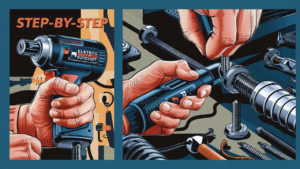PTZ cameras are versatile tools in modern surveillance and streaming. They offer flexibility and control.
PTZ stands for Pan-Tilt-Zoom. These cameras can move horizontally and vertically. They can zoom in and out, providing a wide range of views. This makes PTZ cameras ideal for monitoring large areas and capturing detailed images. They are widely used in security systems, live events, and online streaming.
Understanding how PTZ cameras work can enhance your surveillance strategy. It also helps in producing high-quality streams. This blog will explore the mechanics and features of PTZ cameras. You will learn how they operate and why they are popular. Let’s dive into the world of PTZ cameras and see how they can benefit your surveillance and streaming needs.
Introduction To Ptz Cameras
PTZ cameras have become essential tools in the realm of surveillance and streaming. Known for their versatility, these cameras offer remarkable features. Let’s delve into what makes PTZ cameras stand out.
What Ptz Stands For
PTZ stands for Pan-Tilt-Zoom. These three functions define how the camera operates. “Pan” means moving the camera horizontally. “Tilt” refers to vertical movement. “Zoom” allows for close-up or wide-angle views. Together, they provide comprehensive coverage.
Importance In Surveillance
PTZ cameras play a crucial role in surveillance. They cover large areas with fewer cameras. This means reduced costs and better management. Their zoom function can capture fine details. This helps in identifying faces or license plates.
These cameras are also programmable. They can follow preset patterns. This ensures continuous monitoring. PTZ cameras adapt to different environments. Indoors or outdoors, they perform well.
Their real-time control offers another advantage. Security personnel can adjust the camera as needed. This flexibility enhances security measures. Overall, PTZ cameras provide an effective solution for surveillance needs.
Core Components
Understanding the core components of PTZ cameras can help you appreciate their capabilities. These components work together to provide high-quality surveillance and streaming.
Camera Lens
The camera lens captures visual information. It determines the image quality and field of view. High-resolution lenses ensure clear and detailed footage. PTZ cameras often use wide-angle lenses for broader coverage.
Pan/tilt Mechanism
The pan/tilt mechanism allows the camera to move horizontally and vertically. This movement provides a wider surveillance area. Users can control the direction remotely. This feature is essential for tracking moving objects.
Zoom Functionality
Zoom functionality lets you focus on specific details. Optical zoom maintains image quality while zooming in. Digital zoom can enhance the image further. PTZ cameras often combine both types for flexibility.
How Ptz Cameras Operate
PTZ cameras, or Pan-Tilt-Zoom cameras, are essential tools for surveillance and streaming. They offer flexibility and control over camera movements, making them ideal for various applications. Understanding how PTZ cameras work can help you choose the right one for your needs.
Motion Control
PTZ cameras have motors that allow them to move in different directions. The pan function moves the camera horizontally. The tilt function moves the camera vertically. Together, they cover a wide area. These movements can be controlled remotely. This makes it easy to adjust the camera’s position without being there.
Zoom Capabilities
Zooming is another key feature of PTZ cameras. Optical zoom uses the camera’s lenses to magnify the image. Digital zoom enhances the image using software. Optical zoom provides clearer images than digital zoom. PTZ cameras can zoom in on distant objects. This is useful for surveillance and streaming events.
Image Processing
PTZ cameras use advanced image processing technology. They adjust lighting and focus automatically. This ensures high-quality images in different conditions. Some cameras have features like night vision. They can capture clear images even in low light. Image stabilization is another feature. It reduces blurriness caused by camera movement.
Integration With Surveillance Systems
PTZ cameras enhance surveillance and streaming by providing flexible control over viewing angles. They offer pan, tilt, and zoom capabilities for detailed monitoring.
PTZ cameras, or pan-tilt-zoom cameras, have revolutionized both surveillance and streaming. Their ability to move and zoom makes them invaluable tools. But how do they integrate with existing surveillance systems?
Network Connectivity
Network connectivity is crucial for PTZ cameras. These cameras connect to your network through either Wi-Fi or Ethernet.
This allows you to monitor from anywhere. Imagine checking your home security from your phone while on vacation.
You can also integrate multiple cameras into one system. This provides comprehensive coverage of large areas.
Software Integration
Software integration makes using PTZ cameras even easier. Many cameras come with their own software. This software can be installed on your computer or smartphone.
You can also use third-party software. This can offer more features and better customization.
For instance, I once used a third-party app that allowed me to set specific patrol routes for the camera. This way, the camera could automatically scan the room at regular intervals.
Remote Access
Remote access is a game-changer. With PTZ cameras, you can control and view footage from anywhere.
Have you ever worried about your home while at work? With remote access, you can check in anytime.
This feature is also useful for businesses. Managers can oversee multiple locations without being physically present.
Isn’t it amazing how much peace of mind this technology can bring?
By understanding these aspects, you can fully harness the power of PTZ cameras for surveillance and streaming. What features do you find most exciting?
Ptz Cameras For Live Streaming
PTZ cameras are popular for live streaming. They offer flexibility and control. PTZ stands for Pan, Tilt, and Zoom. These features allow the camera to move in different directions. You can also zoom in and out. This makes PTZ cameras ideal for capturing live events. They are used in many places. Examples include churches, classrooms, and sports events. PTZ cameras can be controlled remotely. This means you can adjust the camera view without being there.
Streaming Protocols
Streaming protocols are important for live streaming. They ensure smooth video transmission. Common protocols include RTMP, RTSP, and HLS. RTMP is used for low-latency streaming. It is popular on platforms like YouTube and Facebook. RTSP is good for real-time streaming. HLS is used for delivering content to mobile devices. Choosing the right protocol depends on your needs.
Video Quality
Video quality matters for live streaming. High-definition video keeps viewers engaged. PTZ cameras can stream in 1080p or even 4K. Clear video enhances the viewing experience. Lighting also affects video quality. Ensure good lighting conditions. Adjust the camera settings for the best picture. Test different settings to find what works best.
Latency Issues
Latency can be a problem in live streaming. It is the delay between the real event and the stream. Low latency is crucial for real-time interaction. PTZ cameras with low-latency features help. Check your internet connection too. A stable connection reduces latency. Adjust the streaming settings if needed. Use a wired connection for better results. Monitor the stream to ensure it runs smoothly.

Advantages Of Ptz Cameras
PTZ cameras are popular in both surveillance and streaming. They offer several advantages that make them a preferred choice for various applications. This section delves into the key benefits of PTZ cameras.
Flexibility
PTZ cameras offer great flexibility. They can pan, tilt, and zoom. This allows users to adjust the camera’s view remotely. You can follow moving objects or people. You can also focus on specific areas without repositioning the camera physically.
Wide Coverage
One PTZ camera can cover a large area. This reduces the need for multiple cameras. Its ability to move in different directions provides comprehensive coverage. This feature is ideal for large spaces like parking lots or warehouses.
Enhanced Security
PTZ cameras enhance security. They can track suspicious activities in real-time. They can also zoom in on details like faces or license plates. This makes them effective in monitoring and identifying potential threats. Their versatility ensures they can adapt to various security needs.
Challenges And Limitations
PTZ cameras offer versatility for surveillance and streaming. Despite their benefits, they come with challenges and limitations. Understanding these can help users make informed decisions.
Cost
PTZ cameras are often expensive. High-quality models can cost several thousand dollars. The initial investment might be prohibitive for some users.
Additionally, there are ongoing costs for software and accessories. These expenses add up, making PTZ cameras a significant financial commitment.
Complexity
Setting up PTZ cameras can be complex. Users need technical skills to configure them properly. Without proper setup, the cameras might not function as intended.
Operating PTZ cameras requires understanding their features. This can be challenging for those unfamiliar with advanced technology.
Maintenance
Maintenance is another challenge. PTZ cameras have moving parts that can wear out. Regular maintenance is required to ensure they work smoothly.
Furthermore, software updates are necessary. Keeping the firmware up-to-date is crucial for optimal performance and security.
Future Trends
PTZ cameras offer flexible surveillance with their ability to pan, tilt, and zoom. These features make them ideal for both security and live streaming. Users can remotely control the camera, enhancing monitoring efficiency.
### Future Trends
The future of PTZ (pan-tilt-zoom) cameras is incredibly promising, especially for surveillance and streaming. With rapid advancements in technology, these cameras are becoming smarter, more efficient, and increasingly user-friendly. Let’s dive into some of the most exciting trends shaping the future of PTZ cameras.
Ai Integration
AI is changing the game for PTZ cameras. Imagine a camera that not only captures video but also understands what it sees.
AI-driven PTZ cameras can automatically track movement, recognize faces, and even differentiate between objects. This means fewer false alarms and more accurate surveillance.
I recently installed an AI-enabled PTZ camera at my home. It alerts me only when someone approaches the door, not when a tree sways in the wind. This makes monitoring so much easier and less stressful.
Improved Analytics
Enhanced analytics are making PTZ cameras much smarter. These cameras can now analyze video footage in real-time and provide valuable insights.
For instance, in a retail setting, PTZ cameras can help understand customer behavior. They can track how people move through a store, which products attract the most attention, and even identify peak shopping hours.
Imagine the advantage this gives you in optimizing store layouts and improving customer experience. These insights can be game-changers for your business strategy.
Smarter Controls
PTZ cameras are also getting easier to control. Advanced software allows you to manage multiple cameras from a single interface.
You can preset camera positions, automate movements, and even control cameras remotely via smartphone apps. This means you can keep an eye on things no matter where you are.
I once had to leave town unexpectedly and was able to monitor my home and adjust camera positions right from my phone. This kind of control is not just convenient; it’s empowering.
Isn’t it amazing to think about the potential these future trends hold? How do you see AI, analytics, and smarter controls transforming your use of PTZ cameras?
Choosing The Right Ptz Camera
Choosing the right PTZ (Pan-Tilt-Zoom) camera can be a daunting task, especially with the variety of options available. A good PTZ camera ensures you capture high-quality footage for surveillance or streaming. In this section, we’ll break down the key features to consider, highlight some popular brands, and share user reviews to help you make an informed decision.
Key Features To Consider
When selecting a PTZ camera, focus on the resolution. Higher resolution ensures clearer images.
Consider the camera’s zoom capabilities. Optical zoom is more important than digital zoom as it maintains image quality.
Check the camera’s pan and tilt range. A wider range allows better coverage.
Look for low-light performance. Cameras with good low-light capabilities perform better in varied lighting conditions.
Evaluate the connectivity options. Ensure it supports the type of network you use.
Consider the build quality and weather resistance. This is crucial for outdoor surveillance cameras.
Think about the ease of installation and use. Some cameras come with user-friendly apps for easy control.
Popular Brands
Several brands stand out in the PTZ camera market:
- Hikvision: Known for their robust build and excellent video quality.
- Axis Communications: Offers high-end cameras with advanced features.
- Sony: Renowned for their exceptional low-light performance.
- Logitech: Provides affordable options for smaller setups.
These brands offer a range of models, so you can find one that fits your needs and budget.
User Reviews
Reading user reviews can offer valuable insights. Many users highlight the reliability of Hikvision cameras for 24/7 surveillance.
Axis Communications often receives praise for their advanced features, despite the higher price tag.
Sony users frequently comment on the superior image quality, even in low-light conditions.
Logitech cameras are appreciated for their affordability and ease of use, making them ideal for smaller setups or beginners.
Have you ever struggled to choose the right PTZ camera? What features do you prioritize in a surveillance or streaming camera? Share your thoughts in the comments below!
Installation And Setup
Setting up PTZ cameras for surveillance and streaming is crucial for optimal performance. Proper installation ensures you capture clear footage and can control the camera smoothly. Let’s dive into the essential steps to get you started.
Mounting Options
Choosing the right mounting option is vital. You can mount your PTZ camera on a wall, ceiling, or pole. Each option offers different advantages.
Wall mounts are great for indoor use, providing a stable base. Ceiling mounts are ideal for covering large areas, like warehouses. Pole mounts are perfect for outdoor surveillance, offering a high vantage point.
Evaluate your space and determine which mounting option suits your needs best. Consider factors like field of view and accessibility.
Configuration Tips
Once mounted, configuring your PTZ camera is the next step. Start with basic settings like resolution and frame rate. Higher resolution ensures better image quality.
Set up presets for common angles. This allows you to quickly switch views during surveillance or streaming. Adjust the pan, tilt, and zoom settings to cover the desired area.
Ensure your camera is connected to a stable network. This prevents lag and ensures smooth streaming. Test your configurations to ensure everything works as expected.
Troubleshooting
Issues can arise during installation and setup. Common problems include connectivity issues and poor image quality.
Check your network connection first. Ensure the camera is properly connected and receiving a strong signal. Restart your router if needed.
If image quality is poor, review your settings. Ensure the resolution is set correctly and adjust the focus if necessary. Clean the camera lens if you notice any smudges or dirt.
Encountering other issues? Consult the user manual or reach out to customer support. They can provide specific solutions tailored to your camera model.
How will you ensure your PTZ camera is installed correctly and functions smoothly? Share your thoughts or experiences in the comments below!
Frequently Asked Questions
Are Ptz Cameras Good For Live Streaming?
Yes, PTZ cameras are excellent for live streaming. They offer flexibility, remote control, and high-quality video. Ideal for various events.
What Is The Disadvantage Of Ptz Camera?
PTZ cameras are expensive and complex to install. They require constant monitoring and maintenance.
How Does Ptz Security Camera Work?
A PTZ security camera works by allowing remote control of pan, tilt, and zoom functions. Users can adjust the camera angle and magnification to monitor different areas. This flexibility provides comprehensive coverage and detailed views for effective surveillance.
Do Ptz Cameras Work Only With Internet?
No, PTZ cameras don’t require internet. They can operate locally via wired connections, including Ethernet or RS485.
Conclusion
PTZ cameras offer versatile surveillance and streaming solutions. They provide flexible monitoring. You can control them remotely for better coverage. Their zoom and pan features capture detailed footage. PTZ cameras are ideal for live streaming events. They ensure clear and focused videos.
Investing in PTZ cameras boosts your security. They are user-friendly and effective. Choose PTZ cameras for reliable surveillance and streaming. Enjoy peace of mind and quality videos.








